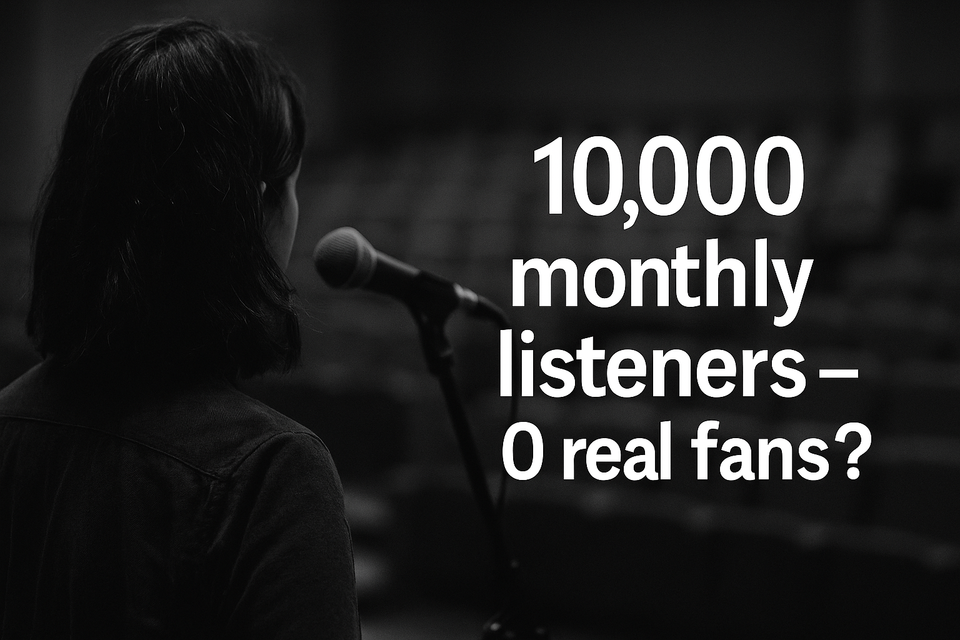Spotify Metrics Explained: What’s the difference between listeners and streams?

Spotify gives artists access to a wide range of performance data — but not all metrics mean the same thing. Before you can interpret your stats, you need to understand how they’re defined.
This article breaks down the key Spotify terms — monthly listeners, streams, followers, and saves — based on Spotify's own logic and tracking system. Artists.
What Are Monthly Listeners?
“Monthly listeners” refers to the number of unique users who have played an artist’s track at least once during a 28-day rolling window. If one user listens to five different songs by the same artist, it still counts as one monthly listener.
Key point:
- Monthly listeners measure reach – how many individual people are hearing your music.
- They do not reflect how often or how long someone listens.
What Are Streams?
“Streams” count the total number of times a track has been played for over 30 seconds. If one person listens to the same track ten times, it counts as ten streams.
Key point:
- Streams measure activity – how often people are listening.
- A high stream count can come from a small number of dedicated fans – or passive listeners on repeat.
Why This Difference Matters
It’s easy to assume more monthly listeners means more success – but that’s not always true.
For example:
- Artist A: 50,000 monthly listeners / 60,000 streams = ~1.2 streams per listener
- Artist B: 2,000 monthly listeners / 20,000 streams = 10 streams per listener
Artist B has fewer people listening, but they listen more often. This signals deeper fan engagement and often leads to better long-term results – merch sales, tickets, fan retention.
What Is a Healthy Ratio?
There’s no fixed benchmark, but here are some general guidelines:
- 1:1 to 1:2 – Passive reach (e.g., one time listening, playlist placements)
- 1:3 to 1:5 – Moderate engagement (some repeat listens, casual fans)
- 1:6 to 1:10+ – Strong fanbase activity (listeners return, explore your catalog)
Higher is not always better – context matters. But if you’re consistently above 1:5, it usually means your music is connecting with people on a deeper level.
Don’t Fake the Ratio
It might be tempting to boost your ratio by asking fans to stream your music on loop. Don’t.
Spotify explicitly classifies looped or incentivized plays as artificial activity. If their system detects unnatural patterns, those streams may be filtered out – or worse, your account could be flagged or demoted in visibility.
Organic engagement is what counts. Focus on making music people want to replay – not on manipulating the system.
What Artists Really Should Track
Rather than obsessing over just one metric, consider these more meaningful indicators:
- Streams per listener ratio: Are people coming back?
- Save rate: Are listeners saving your track to their library?
- User library vs. playlists: Are people saving the song into their personal collection, or is it just temporarily placed in a playlist that drops it after four weeks?
- Algorithmic picks: Are your songs picked up by Spotify’s recommendation engine (e.g. Radio, Autoplay, Discover Weekly)?
- Follower growth: Monthly listeners go up and down – followers stay.
Real-World Examples
Scenario 1:
A new track gets placed in several playlists. Monthly listeners go up quickly – say 15,000 – but the stream ratio stays at 1:2. After four weeks, the track is removed from most lists. Monthly listeners drop, but the ratio improves to 1:5 or more, because now only the real listeners remain.
This is typical for small artists: exposure first, engagement later.
Scenario 2:
Same release setup, but this time the track triggers Spotify’s algorithmic engine (e.g., Radio, Autoplay). Monthly listeners stay high even after four weeks. But the stream ratio doesn’t improve. The audience changes constantly, but no real fanbase forms.
Takeaway:
Visibility doesn’t mean connection. And stability doesn’t always mean growth.
Conclusion
Spotify stats can be useful – or misleading.
Monthly listeners tell you how far your reach goes, but they do not reflect your fanbase. That’s visible in your streams per listener ratio and – most of all – in your follower count.
Focusing too much on monthly listeners is not just unhelpful – it can be damaging. It encourages shortcuts, fake streams, and ultimately kills long-term growth.
Don’t let high listener numbers distract you from the real goal:
Turning listeners into fans, and fans into a lasting audience.
View all articles about Spotify
“If you’re looking for a reliable way to distribute your music to Major Platforms , NexaTunes offers direct distribution with transparent terms. Learn more here → NexaTunes-Distribution”
NexaTunes – structured support for independent releases.
Get in touch for more information using our livechat
